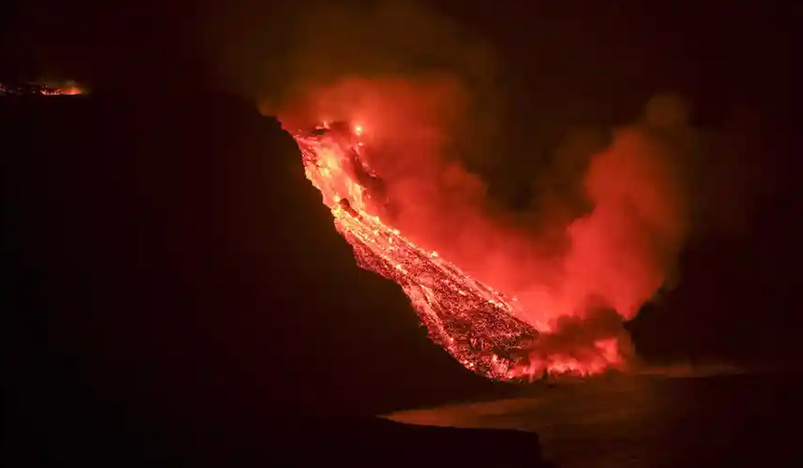
Clouds of steam can be seen as scorching lava enters the Atlantic Ocean
Lava from an erupting volcano on Spain's La Palma island has reached the Atlantic Ocean, raising fears of toxic gases being released and explosions.
Clouds of white steam were seen rising as a red-hot current made contact with the water in the Playa Nueva area.
This could trigger a chemical reaction involving chlorine, which can irritate the skin and eyes and affect breathing.
Hundreds of homes have been destroyed since the Cumbre Vieja volcano in the Canary Islands erupted on 19 September.
About 6,000 people have been evacuated, as the lava was engulfing houses, schools and some banana plantations.
The lava reached the ocean late on Tuesday, the Canary Islands Volcanic Institute, Involcan, tweeted.
There are also fears that parts of the shoreline could now collapse, triggering explosions.
Three coastal villages were earlier locked down in anticipation of the lava making contact with the water.
The Spanish authorities have declared La Palma - the most north-westerly island of the archipelago off the north African coast - a disaster zone, pledging financial support for all those affected by the volcanic activity.
La colada alcanza el mar. Imagen tomada desde el buque oceanográfico Ramón Margalef. pic.twitter.com/gQGoKfkwig
— Instituto Español de Oceanografía (@IEOoceanografia) September 28, 2021
When lava comes into contact with ocean water, it produces a gas plume known as laze - lava and haze.
Laze forms through a series of chemical reactions as hot lava boils the colder sea water.
"It creates a steam of hydrochloric acid, water vapour and bits of ash," science journalist and volcanologist Dr Robin George Andrews told the BBC when the volcano first erupted. "Obviously, it's not good to breathe in."
Laze plumes can cause eye, lung and skin irritation but should not be a problem if residents keep their distance, he said.
Volcanic explosions were also possible, he added, because lava entering sea water creates "a pressure-cooker situation" that "might fling out volcanic debris".
There was an incident in Hawaii where a chunk of molten rock, known as a lava bomb, crashed into a tourist boat off Hawaii's coast in 2018, injuring 23 people.
Authorities have set up an exclusion zone around the lava, including in the sea, to keep people away from any potential danger.
Source: BBC
.jpg)
Qatar Secures Place Among the World's Top 10 Wealthiest Nations
.jpg)
Hamad International Airport Witnesses Record Increase in Passenger Traffic

Saudi Arabia: Any visa holder can now perform Umrah

What are Qatar's Labour Laws on Annual Leave?
Leave a comment